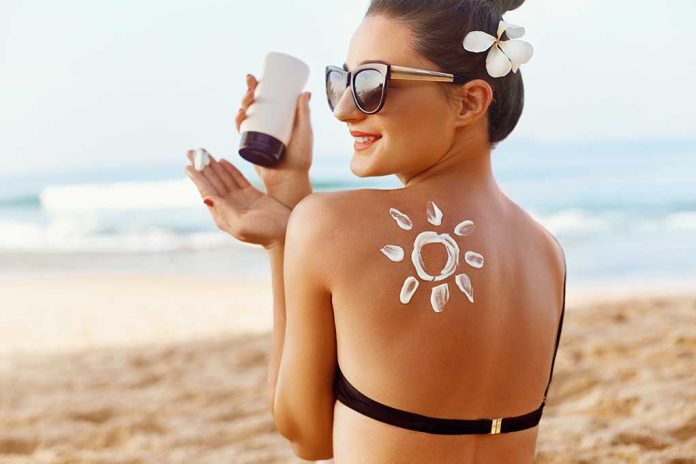
Your beach bag sunscreen could be dangerous: a shocking EWG report finds 80% of products fail basic safety standards, putting millions of Americans at risk this summer.
Key Takeaways
- Environmental Working Group’s review of over 2,000 sunscreen products found nearly 80% failed to meet safety, health, and effectiveness standards
- Spray sunscreens (26% of the market) pose serious inhalation risks, while some contain benzene, a known carcinogen
- Many products contain undisclosed fragrance blends that may include allergens, hormone disruptors, or carcinogens
- Experts recommend mineral sunscreens with zinc oxide or titanium dioxide instead of chemical filters
- Only 25% of tested products were deemed effective, highlighting a serious public health concern
Widespread Safety Failures in Popular Sunscreens
A comprehensive review by the Environmental Working Group has revealed alarming safety concerns in American sunscreen products. The EWG examined over 2,000 SPF products currently available in the United States market, with the disturbing finding that approximately 80% failed to meet their criteria for safety, health, and effectiveness. This represents a significant threat to public health as millions of Americans prepare for summer activities, unknowingly applying products that may cause more harm than good. The findings underscore a critical gap in consumer protection regarding products that are meant to safeguard health.
“Wearing any sunscreen is much more important and offers better sun protection for your skin than not applying anything. But not all sunscreens are created equal,” Stated Dr. David Andrews.
The investigation highlighted particular concern with spray sunscreens, which constitute 26% of the U.S. market. These products present serious risks due to the inhalation of zinc oxide and titanium dioxide particles, which can cause respiratory issues when breathed in. Even more alarming is the detection of benzene, a known carcinogen, in some aerosol sunscreens. This dangerous chemical can cause leukemia and other blood disorders, which has already prompted recalls of certain products. The Biden administration’s FDA has failed to properly regulate these harmful chemicals, putting profits before people.
Hidden Dangers in Sunscreen Ingredients
The EWG report exposed numerous hidden dangers in common sunscreen ingredients that manufacturers aren’t transparent about. Many products contain undisclosed fragrance blends, which may include allergens, hormone disruptors, or even carcinogens. This lack of transparency prevents consumers from making informed choices about what they’re applying to their skin. Additionally, the report flagged butyloctyl salicylate (BOS) as particularly concerning. This chemical is frequently used to artificially boost SPF numbers but may be linked to developmental and reproductive toxicity.
The good news is that manufacturers are beginning to respond to consumer concerns. Oxybenzone, once common in sunscreens and linked to hormone disruption, is now found in only 9% of products, down from previous years. Similarly, the use of vitamin A (retinyl palmitate) has decreased significantly due to research suggesting it may actually accelerate skin damage when exposed to sunlight. These industry shifts demonstrate that market pressure from informed consumers can drive positive change when government regulators fail to protect Americans.
Recommendations for Safer Sun Protection
In light of these findings, the EWG has made specific recommendations for Americans seeking safer sun protection options. They strongly advise consumers to choose mineral sunscreens containing zinc oxide or titanium dioxide rather than chemical filters, which pose greater health and environmental risks. The EWG Verified Program identifies sunscreens that meet stricter safety and effectiveness standards, ensuring full ingredient transparency and protection against both UVA and UVB rays. This independent verification helps cut through marketing claims and provides a reliable guide for concerned citizens.
“The shift reflects growing awareness of oxybenzone’s high absorption through the skin and other potential health harms,” Stated Mckenzie Beard.
The report also challenges the marketing hype around high SPF products, noting that sunscreens with SPF 50 or higher may not offer significantly better protection than those with lower ratings. Instead, they emphasize that the best sunscreen is one that is applied frequently and consistently. Americans should also remember that clothing, hats, and seeking shade are valuable forms of sun protection that don’t involve potentially harmful chemicals. This common-sense approach to sun safety is something the radical left’s regulatory agencies should have been promoting instead of allowing dangerous products to flood store shelves.



